Suwon City Tour
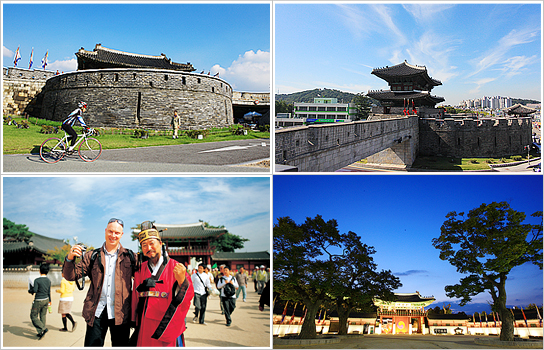
Hwaseong Fortress was built as part of a planned city constructed by King Jeongjo, the 22nd monarch of the Joseon Dynasty. It served as the southern gate of the capital city of Seoul during the Joseon Dynasty. Located in Suwon-si, Gyeonggi-do, the area was a strategic site for military security, and Hwaseong Fortress served as a key site for commerce. Today, Hwaseong Fortress is surrounded by many roads both small and major in addition to the Gyeonggi Provincial Government Building, giving many the opportunity to view the scenic juxtaposition of old and modern architecture. For a quick and convenient way to visit a variety of attractions during your stay in the city, take a ride on the Suwon City Tour, operated by the Suwon City Government. Accompanied by guides who are proficient in English and Japanese, you'll be able to ride in comfort as you discover some of the most celebrated treasures of Suwon.
Visitor Information
|
☞ Period of operation: Year-round (except most Mondays)
☞ Itinerary: Itinerary 1 – Hwaseong Fortress Course Suwon TIC Haeujae Hwaseomun Gate Hwaseong Haenggung Palace Janganmun Gate Hwahongmun Gate Yeonmudae Suwon Hwaseong Museum Suwon TIC Itinerary 2 – Hwaseong & Osan-si Course Suwon TIC Hwaseonmun Gate Janganmun Gate Hwahongmun Gate Hwaseong Haenggung Palace Yeonmudae Lunch Yungneung / Geolleung Yongjusa Temple Mulhyanggi Arboretum ☞ Hours of operation: Itinerary 1: Two departures daily (Tues. through Sun. / 10:00 & 14:00 / tour duration: 3hr, 30min) Itinerary 2: One departure a week (Sundays at 09:30 / tour duration: approx. 7hr) ☞ Tour bus fare: Itinerary 1: Adults (19+): 11,000 won / Youths (7-18): 8,000 won / Children (under 7): 4,000 won Itinerary 2: Adults (19+): 15,000 won / Youths (7-18): 11,000 won / Children (under 7): 5,000 won ☞ Point of departure: Suwon Station (Subway Line 1), Exit 4, in front of Suwon Tourist Information Center ☞ Inquiries & Reservation: Online: www.suwoncitytour.co.kr (Korean, English, Japanese, Chinese) Phone: +82-31-256-8300 (Korean, English, Japanese) ☞ Suwon Tourism Homepage: http://eng.suwon.ne.kr (Korean, English, Japanese, Chinese) ☞1330 Korea Travel Hotline: +82-2-1330 (Korean, English, Japanese, Chinese) |
<Major Tourist Attractions>
Hwaseomun Gate
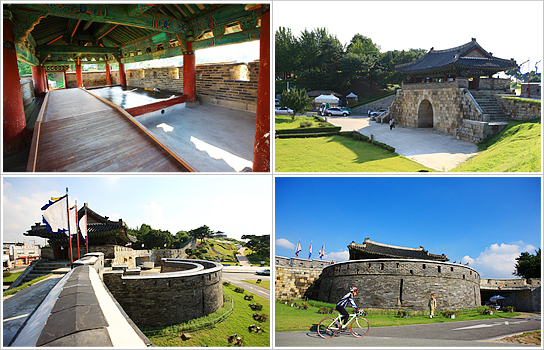
Hwaseomun (National Treasure No. 403) is the western gate of the famous Hwaseong Fortress. The stately stone gate is topped with a single-story pavilion and is guarded by a protective semicircle stone wall known as Ongseong.
☞ Go to Hwaseomun Gate
Hwaseong Haenggung Palace
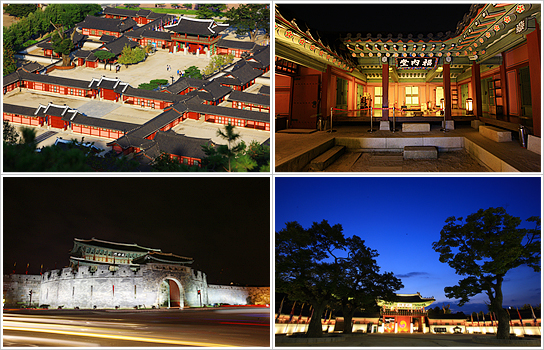
Haenggung Palace (행궁) refers to the temporary palaces built outside the capital city. Used by the royal family as a way to escape the dangers of war or to take a brief reprieve from the pressures of palace life, Hwaseong Haenggung Palace was also used occasionally by King Jeongjo during his visits to his father's tomb. The palace is a magnificent display of architecture and is considered the most noteworthy of the Haenggung Palaces.
☞ Go to Hwaseong Haenggung Palace
Janganmun Gate
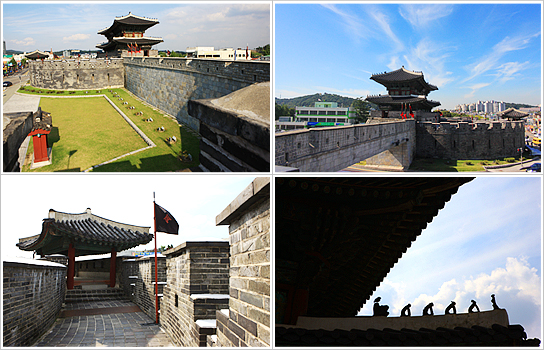
Janganmun Gate, on the northern side of the Suwon Hwaseong Fortress, is the main entrance to the fortress. "Jangan" means "capital city," and highlights the importance of the city of Suwon by giving it the same status as the capital city of Hanyang (the ancient city now known as Seoul) where the kings lived during the Joseon Dynasty. This particular gate was the gate through which the king entered the fortress on visits to Suwon. It is so large that it exceeds in size Sungnyemun Gate (National Treasure No. 1), the main gate to Seoul.
☞ Go to Janganmun Gate
Hwahongmun Gate
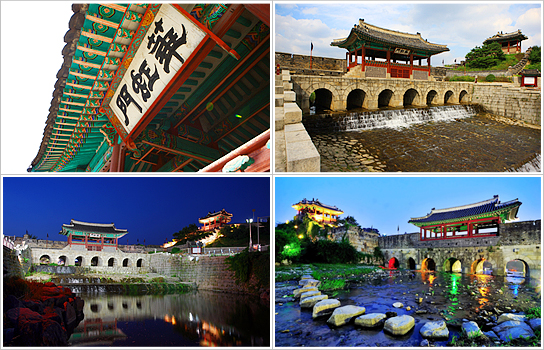
Hwahongmun Gate (화홍문), also known as Buksumun Gate (North Water Gate), is the northern gate of the fortress. The stone gate is topped with a single-story pavilion and is expertly designed with seven arches that allow the waters of Suwoncheon Stream to flow freely through the fortress to the south. The view of the water passing under arches is so beautiful that is has been named one of the "Eight Scenic Beauties of Suwon."
☞ Go to Hwahongmun Gate
Yeonmudae (Dongjangdae)

Located on a hill in the northeast section of the Hwaseong Fortress, Yeonmudae (연무대) is open on all sides and gives visitors an expansive view overlooking the fortress walls. In the past, soldiers gathered here for military training and exercises. Today, visitors can try their hand at archery, participate in traditional sports, or simply enjoy a relaxing walk around the grounds.
☞ Go to Yeonmudae (Dongjangdae)
Suwon Hwaseong Museum
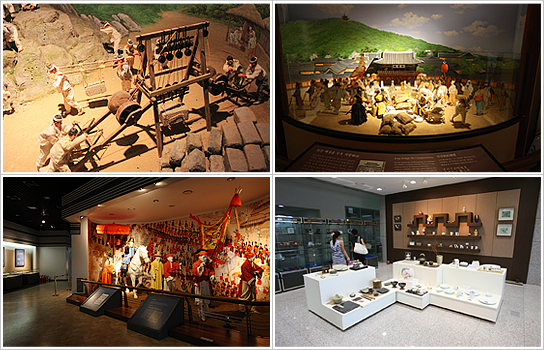
Suwon Hwaseong Museum presents an organized and comprehensive look at the cultural prowess and history of Hwaseong Fortress, a designated World Cultural Heritage. Exhibition halls detail the construction of the fortress as well as the history of the city and how it changed and developed over time. At the library, which remains open year round, visitors can learn more about the many people who played an important role in the construction of the impressive fortress.
☞ Go to Suwon Hwaseong Museum
Yungneung / Geolleung (Yunggeolleung)
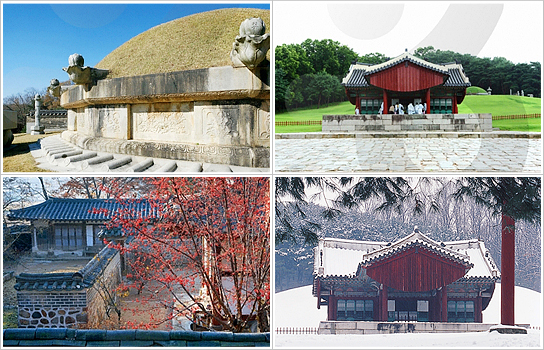
Yungneung (융릉) is the joint tomb of crown prince Sado Seja (Jangjo, 1735-1762) and Sado's wife Hyegyeonggung Hongssi. Geolleung (건릉) is the joint tomb of King Jeongjo (son of Sado Seja) and his wife Queen Hyoui. The tombs are adorned with tombstones and a stone wall.
* For more information on Sado Seja, please see the note at the bottom of the page.
Yongjusa Temple

Yongjusa Temple (용주사) was built in the Silla era, but was destroyed by fire during a war. It was rebuilt in 1790 by King Jeongjo to mourn the tragic death of his father Sado Seja and to pray for the eternal rest of his father's soul. The temple is home to a seven-story stone pagoda and Cheonboru Pavilion, which is supported by six stone columns. Here, visitors will find traditional Buddhist architecture and a number of Buddhist relics.
* For more information on Sado Seja, please see the note at the bottom of the page.
Mulhyanggi Arboretum
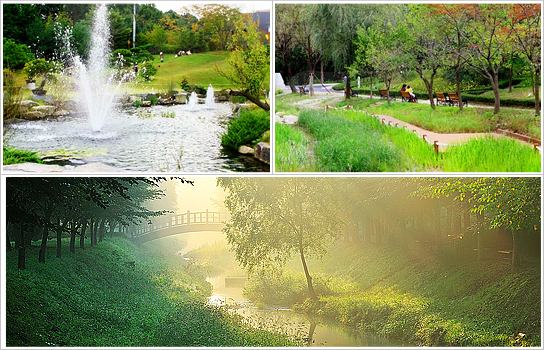
Mulhyanggi Arboretum is a lush arboretum located in downtown Osan, Gyeonggi-do. Standing on a plot of land measuring 100,000-pyeong, the arboretum has 16 themed parks with over 1,700 species of plants and a range of subsidiary facilities. It takes approximately two hours to tour the entire arboretum at a leisurely pace.
* Note
Crown Prince Sado (King Jangjo, 1735-1762) was the second son of King Yeongjo, the 21st king of the Joseon Dynasty (1392-1910). King Yeongjo (1724-1776) is known as one of the greatest kings in history and is credited with turning the kingdom into a powerful dynasty during the 18th century. The honorable king is known for his efforts and relative success in relieving cutthroat political tensions between different factions as well as for his implementation of policies that reduced the burden of excess taxes on the people.
During his reign, the king tragically fell prey to an evil scheme concocted by opposing parties and was tricked into killing his own son by trapping him in an airtight rice bin. After realizing his terrible mistake, Yeongjo was deeply grieved and appointed Jeongjo, the son of Crown Prince Sado, as king. Later, King Jeongjo had his father's grave moved to Suwon and visited frequently with his subordinates to pay tribute and give his heartfelt respects to his father.
Crown Prince Sado (King Jangjo, 1735-1762) was the second son of King Yeongjo, the 21st king of the Joseon Dynasty (1392-1910). King Yeongjo (1724-1776) is known as one of the greatest kings in history and is credited with turning the kingdom into a powerful dynasty during the 18th century. The honorable king is known for his efforts and relative success in relieving cutthroat political tensions between different factions as well as for his implementation of policies that reduced the burden of excess taxes on the people.
During his reign, the king tragically fell prey to an evil scheme concocted by opposing parties and was tricked into killing his own son by trapping him in an airtight rice bin. After realizing his terrible mistake, Yeongjo was deeply grieved and appointed Jeongjo, the son of Crown Prince Sado, as king. Later, King Jeongjo had his father's grave moved to Suwon and visited frequently with his subordinates to pay tribute and give his heartfelt respects to his father.
Comments
Post a Comment